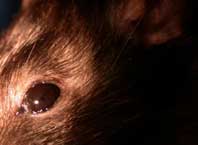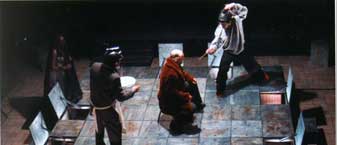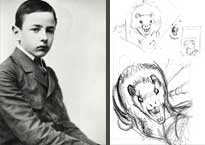Szczur
“For, by an inscrutable force of Nature, even the strongest person has one single thing foreordained in this world that is stronger than him, that is above him and that he cannot tolerate! Some cannot tolerate primroses, others liver, while still others get hives from wild strawberries; but it was an astonishing thing that the murderer, who had not been enfeebled by torture with either little sticks or little pins, was afraid of a rat.”

Written in 1937, The Rat was published in 1939 in the prestigious Warsaw literary journal Skamander. Witold Gombrowicz added it to his collection of stories in its 1957 expanded edition, Bacacay (Wydawnictwo Literackie, Krakow).

This cruel story tells of the physical abuses inflicted upon the murderer Hooligan, a thick brute whose only weakness is a terrible fear of rats, by the old judge Scorrabini. The sadism of the old man, his will to humiliate and force his victim, who was himself a torturer, into submission, and his perverse joy in Hooligan’s terror contribute to the mood of grotesque horror, which culminates in the story’s final scene.

Excerpt: And every day at seven in the evening Skorabkowski would descend into the torture chamber, wearing his tobacco brown housecoat, with little sticks or little wires in his hand. And every night, from seven onward, the appeals judge would labor in the sweat of his brow over the voiceless villain, silently, silently.... Silently he would approach him and to begin with would tickle him on the heel for a long, long time, so as to stimulate him to a spasmodic dainty giggle; then he would administer petty mortifications with the sticks and constrict his field of vision with the aid of boards; he would prick him with pins and show him peas, beans, and small beets... But the brigand did not take it silently, but in silence. And his silence grew, surging and thrusting through the darkness, becoming equal to his most magnificent roars—and it was in vain that the judge attempted with his own silentness to vanquish the bored silence of the bandit—and hatred filled the dungeons! What was it that Skorabkowski actually wanted? He wanted to change the bandit’s nature, refashion his voice, transform his broad laugh into a narrow giggle, reduce his roar to whisper, shorten and diminish his entire figure; in a word, he wanted to make him resemble himself, Skorabkowski. With the assiduity of a tracker he sought his weak points, subjecting him to particular and terrible examinations in order to find that point minoris resistentiae, the weak spot through which he could properly set about the bandit. Yet the bandit exhibited no weak spots, but only remained silent.






